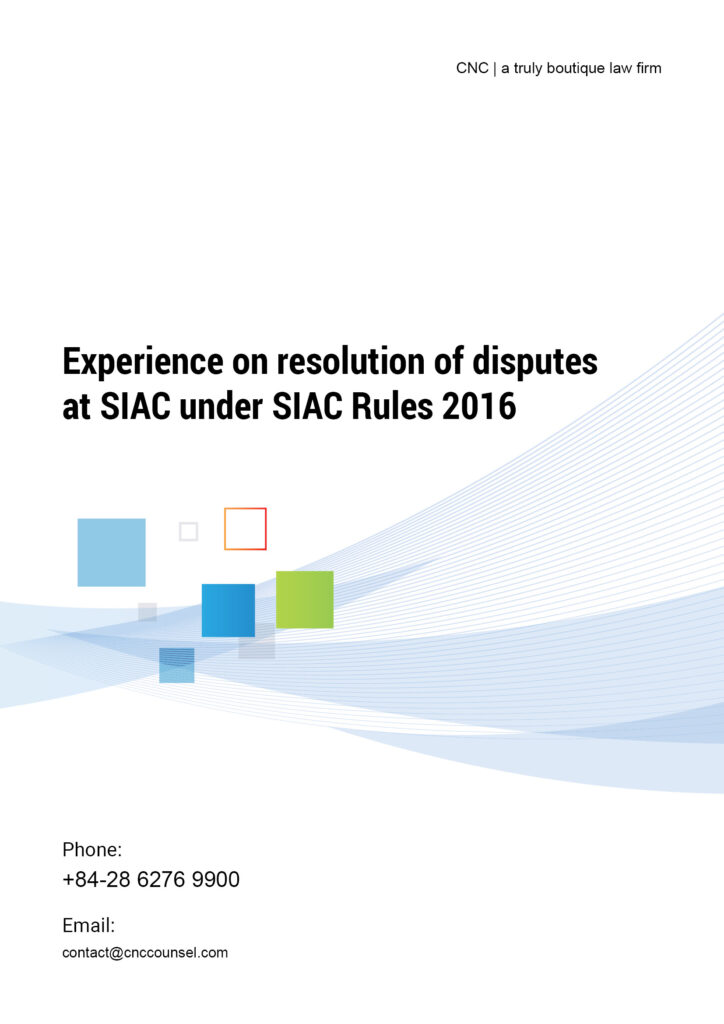Experience on resolution of disputes at SIAC under SIAC Rules 2016
Although SIAC Rules 2025 has been introduced as a replacement for SIAC Rules 2016 for the resolution of disputes at SIAC, CNC finds that more time are required for users to become familiar with SIAC Rules 2025 and apply them in practice.
Meanwhile, most users are well-acquainted with SIAC Rules 2016, which has played a significant role in the elevation of SIAC’s global standing. As such, the procedures for dispute resolution at SIAC under SIAC Rules 2016 remain a matter of great interests to many users.
Therefore, with the aim to provide users with the details on the dispute resolution procedures at SIAC, CNC is pleased to introduce the article “Experience on reoslution of disputes at SIAC under SIAC Rules 2016” to the users for reference and potential application.
This article is prepared based on CNC’s experience in providing support to Clients in relation to resolution of disputes at SIAC throughout the last 9 years. For ease of understanding, CNC simplified the dispute resolution procedures at SIAC under SIAC Rules 2016 into 4 fundamental phases as follows:
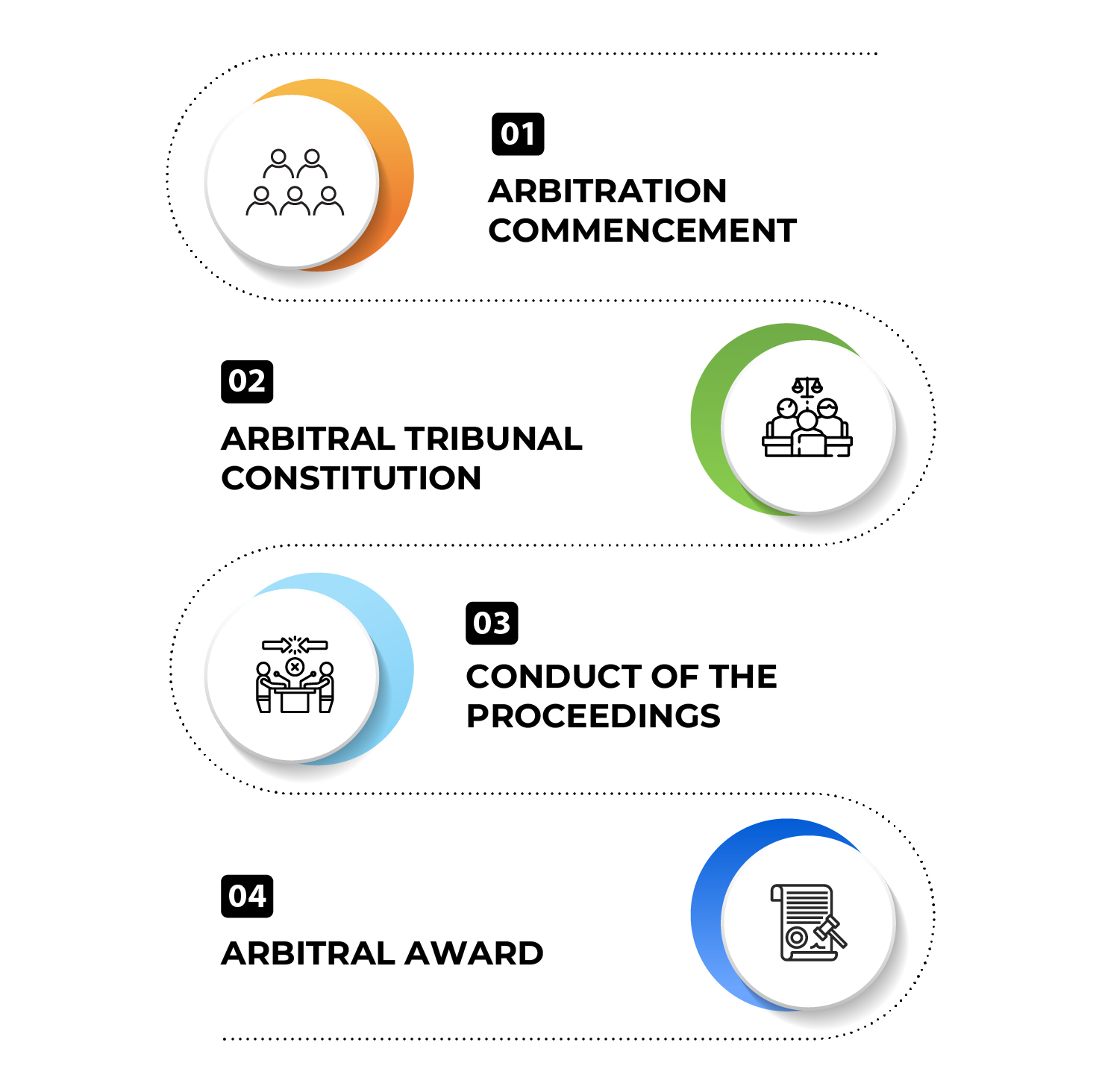
Procedure for dispute resolution at SIAC under SIAC Rules 2016
Phase 1: Arbitration Commencement
During the Arbitration Commencement Phase, there are 04 (four) important issues that users should be aware of during the dispute resolution at SIAC under SIAC Rules 2016, which are:
- Claimant files a Notice of Arbitration
- Respondent files a Response to the Notice of Arbitration
- Parties pay an advance on the Arbitration Cost, and
- The Registrar conduct preliminary review of the jurisdiction of the Arbitral Tribunal
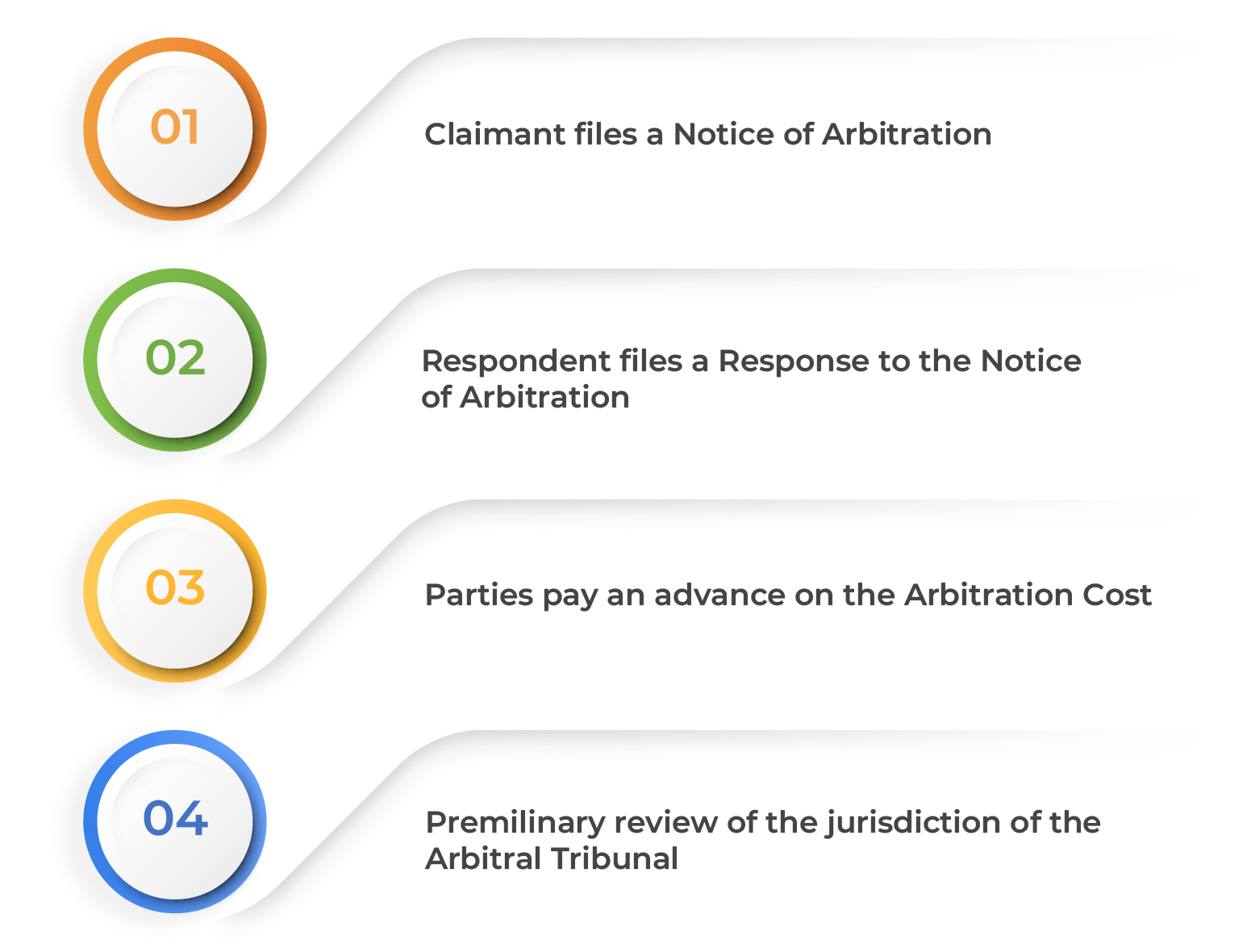
04 important procedures during the Arbitration Commencement Phase at SIAC
Claimant files a Notice of Arbitration
Accordingly, the first step in dispute resolution at SIAC, as well as the prerequisite for the commencement of arbitration in accordance with SIAC Rules 2016, is the filing of Notice of Arbitration with the Registrar and Respondent by the Claimant.[1]
Naturally, it should not be interpretted that the dispute resolution is automatically commenced on the date when the Registrar receives the Notice of Arbitration. In practice, the Registrar would assess whether the Notice of Arbitration fulfill all of the requirements (which shall be delved into in sections below) or not. If yes, SIAC shall notify the Parties of the commencement date of the arbitration (the date on which arbitration is commenced at SIAC);[2]
Vice versa, if the requirements are not fulfilled, the Registrar shall facilitate the Claimant to fulfill all of the requirements and complete the Notice of Arbitration for supplemental submission[3].
Respondent files a Response to Notice of Arbitration
Immediately after commencement of dispute resolution at SIAC, the Respondent should carefully consider whether or not to file a Response to Notice of Arbitration. Under SIAC Rules 2016, the dispute resolution at SIAC would proceed normally even when the Respondent fails to file a Notice of Arbitration.
According to experience of CNC, the filing of Response to Nocite of Arbitration by the Respondent is an appropriate and well-advised course of action. By filing a Response to Notice of Arbitration, the Respondent could explore all of the rights offered by the Arbitration Commencement Phase regarding the following aspects:[4]
- Objection to the jurisdiction of the Arbitral Tribunal (if any);
- Selection of the Arbitrator
- Counterclaim (if any)
- In conjunction with giving a response to the Notice of Arbitration, the Respondent would also demonstrate its respect for responsibility and upholding of the procedures for dispute resolution via Arbitration, which would encourage an amicable attitude from the other parties.
Particularly, the objection to the jurisdiction of the Arbitral Tribunal would serve as an essential basis for SIAC to conduct a preliminary review of the jurisdiction of the Arbitral Tribunal (which shall be delved into in sections below), which might allow the Respondent to conclude the dispute resolution at SIAC prior to the constitution of the Arbitral Tribunal.[5]
The timeframe for the submissions of the Response to Notice of Arbitration is 14 days from the date on which the Notice of Arbitration is received[6]. However, if the Respondent finds that 14 days is not enough to prepare the Response to Notice of Arbitration, the Respondent could request the Registrar to allow an extension of time for submission of the Response to Notice of Arbitration. If the Registrar accepts the request, the Respondent could file the Response to Notice of Arbitration within the extended duration.[7]
Some notes for the parties
3 notes for the Claimant:
First, the Notice of Arbitration must ensure that all of the required content listed in Article 3.1 and Article 3.2, SIAC Rules 2016 are covered, which are[8]:
- A demand that the dispute be referred to arbitration
- The information on parties to the arbitration as well as their representative (if any);
- A reference to the arbitration agreement invoked and a copy of the arbitration agreement
- A reference to the contract or other instrument out of or in relation to which the dispute arises and, where possible, a copy of the contract or other instrument
- A brief statement describing the nature and circumstances of the dispute, specifying the relief claimed and, where possible, an initial quantification of the claim amount;
- A statement of any matters which the parties have previously agreed as to the conduct of the arbitration or with respect to which the Claimant wishes to make a proposal;
- A proposal for the number of arbitrators if not specified in the arbitration agreement;
- The nomination of an arbitrator if the arbitration agreement provides for three arbitrators, or a proposal for a sole arbitrator if he arbitration agreement provides for a sole arbitrator, unless the parties agreed otherwise;
- Any comment as to the applicable rules of law and language of arbitration;
- Payment of the case filing fee; and
- Statement of Claim (if possible).
Second, payment of the case filing fee:
- According to SIAC’s Schedule of Fees applicable starting from 01/01/2025, the case filing fee (non-refundable) is 3.270 Singapore Dollar (which include the 9% Goods and Services Tax) for Singapore parties, and 3,000 Singapore Dollar for oversea parties[9].
- The payment of the case filing fee is one of the prerequisites for SIAC to inform parties of the commencement date of dispute resolution at SIAC[10]to
- Naturally, the Registrar would facilitate the Claimant to make payment for the case filing fee. However, to expedite the dispute resolution at SIAC, the Claimant needs to be aware that the payment of this fee should be made prior to the filing of Notice of Arbitration with the Registrar and Respondent.
Third, methods of submitting Notice of Arbitration.
- Under SIAC Rules 2016, the Claimant might deliver the Notice of Arbitration by hand, registered post or courier service, or transmit it by any form of electronic communication.[11]
- Among the above, the Claimant could submit the Notice of Arbitration to SIAC via the email address of the Case Management Team: casemanagement@siac.org.sg or via the SIAC Gateway[12] at the address: https://siac-gateway.on.opus2.com/
- Currently, as the SIAC Gateway is recently implemented and the users have yet to become familiar with the uses and functions of the system, the traditional method of submitting via the email address of the Case Management Team is recommended.
- This recommendation is also applicable to any submission, notice, or communication between the Parties throughtout the arbitration process.
Upon the fulfillment of the above requirements, the Registrar shall have substantial basis to commence the arbitration case.
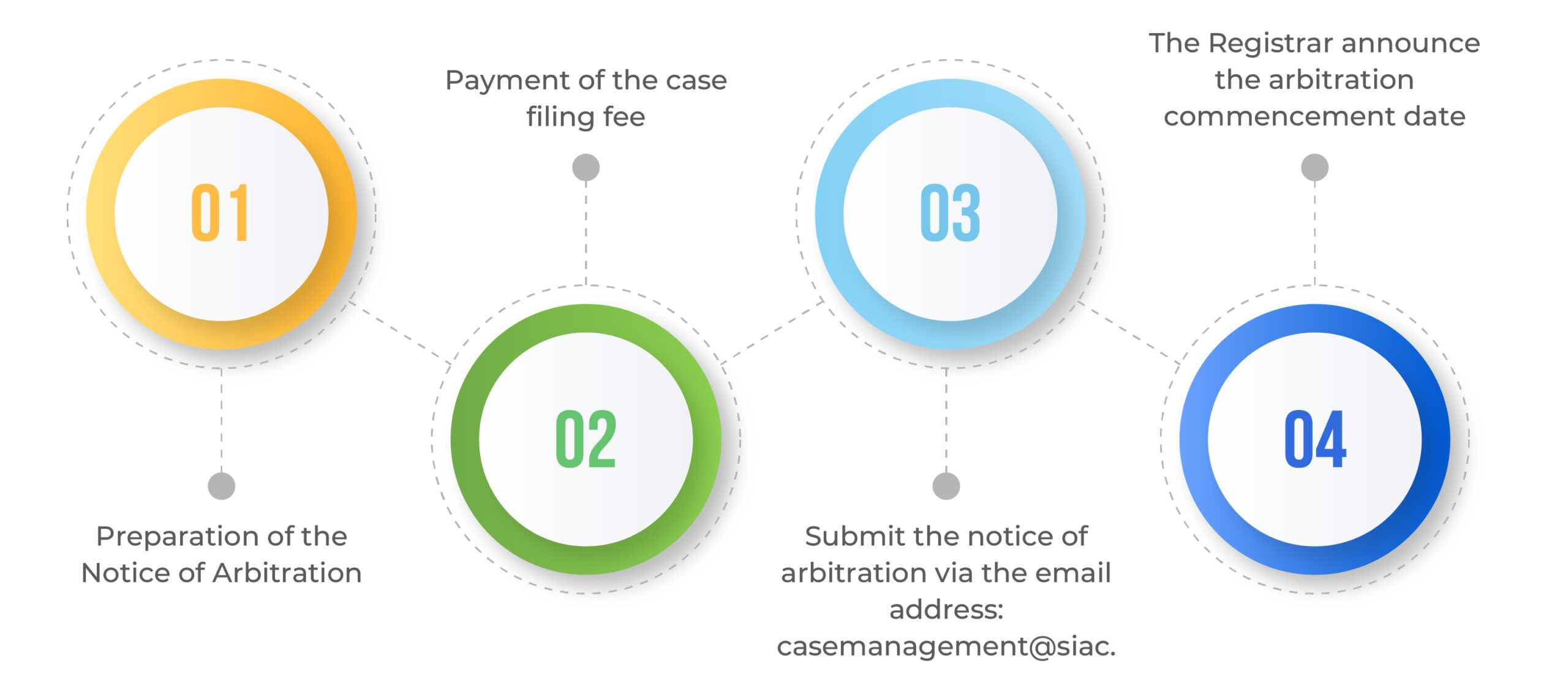
The steps for the Claimant to commence arbitration at SIAC
Similarly, during the dispute resoluion at SIAC, the Respondent should also be aware of the following 8 issues regarding the Response to Notice of Arbitration.
First, regarding the content of the Response to Notice of Arbitraton, the Respondent need:
- A confirmation or denial of all or part of the claims, including any plea that the Tribunal lacks jurisdiction;
- A brief statement describing the nature and circumstances of any counterclaim, specifying the relief claimed and, where possible, an initial quantification of the counterclaim amount;
- Any comment in response to any statements contained in the Notice of Arbitration or any comment with respect to related matters;
- The nomination of an arbitrator if the arbitration agreement provides for three arbitrators or, if the arbitration agreement provides for a sole arbitrator, comments on the Claimant’s proposal for a sole arbitrator or a counter-proposal, unless the parties agreed otherwise;
- Payment of the filing fee for any counterclaim (if any); and
- Statement of Defense and Statement of Counterclaim (if any)
- The payment of the filing fee for counterclaim is the same as the case filing fee applicable to the Claimant
- Naturally, the Respondent is able (but not obligated to) submit the Statement of Defense and Statement of Counterclaim along with the Notice of Arbitration.[13]
Overall, the dispute resolution at SIAC during Phase 1 – Arbitration Commencement would go through the following 9 steps:
- Step 1: The Claimant prepare the Notice of Arbitration
- Step 2: The Claimant make the payment for the Case Filing Fee
- Step 3: Submit the Notice of Arbitration to the Registrar and Respondent via the email address[14]: casemanagement@siac.org.sg;
- Step 4: The Registrar shall inform the parties of the arbitration commencement date (provided that all of the above steps are fundamentally fulfilled)
- Step 5: Make careful consideration regarding whether or not to file the Response to Notice of Arbitration
- Step 6: Consider whether the allocated time is sufficient to prepare the Response to Notice of Arbitration. If not, request the Registrar to grant an extension of time for the preparation of the Response to Notice of Arbitration
- Step 7: Prepare the Response to Notice of Arbitration that address the following issues: (i) objection to the jurisdiction of the Arbitral Tribunal, (ii) selection of appropriate Arbitrator, and (iii) Counterclaim;
- Step 8: Payment of the filing fee for Counterclaim (if any);
- Step 9: Submit the Response to Notice of Arbitration with the details as listed above to the Registrar and the Claimant.
Estimation of Arbitration Cost
To resolve the dispute at SIAC, parties must pay an advance and be responsible for the Arbitration Cost. The Arbitration Cost is applicable to any issues that the Claimant and Respondent referred to the Arbitral Tribunal for resolution[15];
To prepare for the Arbitration Cost, prior to the commencement of dispute resolution at SIAC, Parties could refer to SIAC’s Schedule of Fees, which is applicable since 01/01/2025[16].
Subsequent to the filing of Notice of Arbitration, the Registrar would specify an amount of Arbitration Cost for the Parties to pay in advance, and unless otherwise instructed, each Party shall bear 50% of the Arbitration Cost[17].
At any point in time during the arbitration process, the Registrar could request party to make additional advance[18].
The advance of Arbitration Cost is the responsibilities of Parties to ensure the dispute resolution process at SIAC could be commenced. Therefore, if a Party fails to make the advance payment f(either in part or in whole):
- The Arbitral Tribunal might suspend its work and the Registrar could suspend SIAC’s administration of the Case; and
- The Registrar shall set a time limit for that Party to fulfill their advance payment obligation. Upon the expiration of this duration, if that Party still has yet to make payment, that Party shall be deemed to have withdraw their claims or counterclaims without prejudice to the right to reintroduce the same claims or counterclaims in another proceeding[19].
- In these situations, even if one is not obligated to, the other Party should pay the remaining half of the advance for which the Party that failed to make payment is responble so that the arbitration proceeding is not affected[20].
Upon the conclusion of the arbitral proceeding, the final value of the Arbitration Cost shall be determined by the Registrar. If this amount is lower than the amount advanced, the difference shall be reimbursed to the Party in appropriate proportion[21] .
To sum up, aside from the payment of the case filing fee or filing fee for counterclaim, parties should make arrangement for and fulfill the payment of Arbitration Cost so that the Case could be promptly resolved.
See more on Arbitration Cost here.
Premilinary review of the Arbitral Tribunal’s jurisdiction
In our dispute resolution experience at SIAC, CNC finds that one Party (usually the Respondents in their response to the Notice of Arbitration, or the Claimant in their response to the Counterclaim) would tend to raise objection against the jurisdiction of the Arbitral Tribunal. In principle, the Arbitral Tribunal could decide on their own jurisdiction based on the competence-competence principle. This is a widely recognized principle worldwide not only by the scholar and the law practitioners, but also recorded in Article 16, UNCITRAL Model Law on International Commercial Arbitration.
However, significant waste of time and cost would ensue if the jurisdiction of the Arbitral Tribunal could only be determined subsequent to the constitution of the Arbitral Tribunal. As such, in order to manage the Case effectively, SIAC designed a process which allow the Court to review the Arbitration Agreement between Parties, thereby conducting a preliminary review of the jurisdiction of the Arbitral Tribunal over the case prior to the constitution of the Arbitral Tribunal[22].
After the preliminary review has been completed, the Court would decide whether to resume or terminate the Arbitration. If the Court decide to resume the dispute resolution at SIAC, this decision would not affect the thereafter established Arbitral Tribunal’s power to decide on their own jurisdiction.
In other words, the issues of the jurisdiction of the Arbitral Tribunal would undergo the 02 steps: (i) Preliminary review by the Court prior to the constitution of the Arbitral Tribunal, and (ii) Decision by the Arbitral Tribunal subsequent to the constitution.
Summary of Phase 1 – Arbitration Commencement under SIAC Rules 2016
Overall, Phase 1 – Arbitration Commencement under SIAC Rules 2016 could be simplified into 7 fundamental steps as follow:

7 steps of dispute resolution at SIAC during the arbitration commencement phase
Phase 2: Arbitral Tribunal Constitution
During the Arbitral Tribunal Constitution Phase, users should pay attention to the following 03 (three) matters: (i) Number of Arbitrators; (ii) Process for the appointment of Arbitrators; and (iii) Challenge of Arbitrators. To be specific:

03 important matters during the constitution of the Arbitral Tribunal for the resolution of disputes at SIAC
The number of arbitrators[23]
SIAC Rules 2016 specifies that Parties are allowed to agree on the number of Arbitrators
In the event that there exist no such agreement between the Parties, the number of Arbitrators shall be set to either 01 (one) or (three)
Accordingly, the Registrar, after having consulted with the parties and taking in account the complexity and/or the total value of the dispute value or any other relevant factors, shall set the number of arbitrators to be 03 Arbitrators if it is considered necessary.
Otherwise, the Registrar shall set the number of Arbitrators for the resolution of the dispute to be 01 Arbitrator (the sole arbitrator), adhering to the principle of ensuring a fair, expeditious, and economical dispute resolution process at SIAC.[24]
Process for the Appointment Arbitrators
Similar to the agreement on the number of arbitrators, SIAC Rules 2016 also allow the Parties to agree on the method and process for the appointment of Arbitrators for the dispute resolution
Accordingly, the Parties could agree on whether the Arbitrator could be appointed by one or more of the Parties or by any other third party including the arbitrators already appointed
If there exist no agreement between the parties on the method and process for the appointment of Arbitrators, the appointment shall be made in accordance with the regulations of SIAC Rules 2016
To be specific, in the event of the sole arbitrator, the Parties shall jointly appoint the Arbitrator within 21 days from the arbitration commencement date. The President shall appoint the sole arbitrator in the following cases[25]:
- Parties could not agree on the appointment of the sole arbitrator within the allowed duration; or
- One of the parties request the President to make the appointment prior to the expiration of such duration.
In the event of 03 Arbitrators, the appointment of Arbitrators for dispute resolution shall be made in the following steps[26]:
- Step 1: The first arbitrator shall be nominated by one Party
- Step 2: The second arbitrator shall be nominated by the other party within 14 days of the receipt of the nomination of the first arbitrator;
- Step 3: If one of the parties fail to nominate within the specified time, the President shall appoint the Arbitrator for that party;
- Step 4: The President shall appoint the third arbitrator, who shall also be the presiding arbitrator.
- Naturally, the above timeframe for the nomination of Arbitrators could be changed if the Parties agree on another timeframe , or if one party request the Registrar to grant an extension of time for the nomination of Arbitrator and the Registrar approve this request[27].
It should also be further noted that a nominated arbitrator would not automatically become an appointed arbitrator. This is because the President could decide whether or not a nominated arbitrator could become an appointed arbitrator, this decision is final and not subject to appeal[28].
During the appointment of Arbitrator, the President shall evaluate the arbitrators based on the following criteria[29]
- Independence and impartiality;
- Qualifications as agreed by the parties;
- Sufficient availability to resolve the case in a prompt and efficient manner;
Overall, unless the Parties agreed otherwise, the procedures for the constitution of the Arbitral Tribunal under SIAC Rules 2016 could be summed up via the below flowchart:
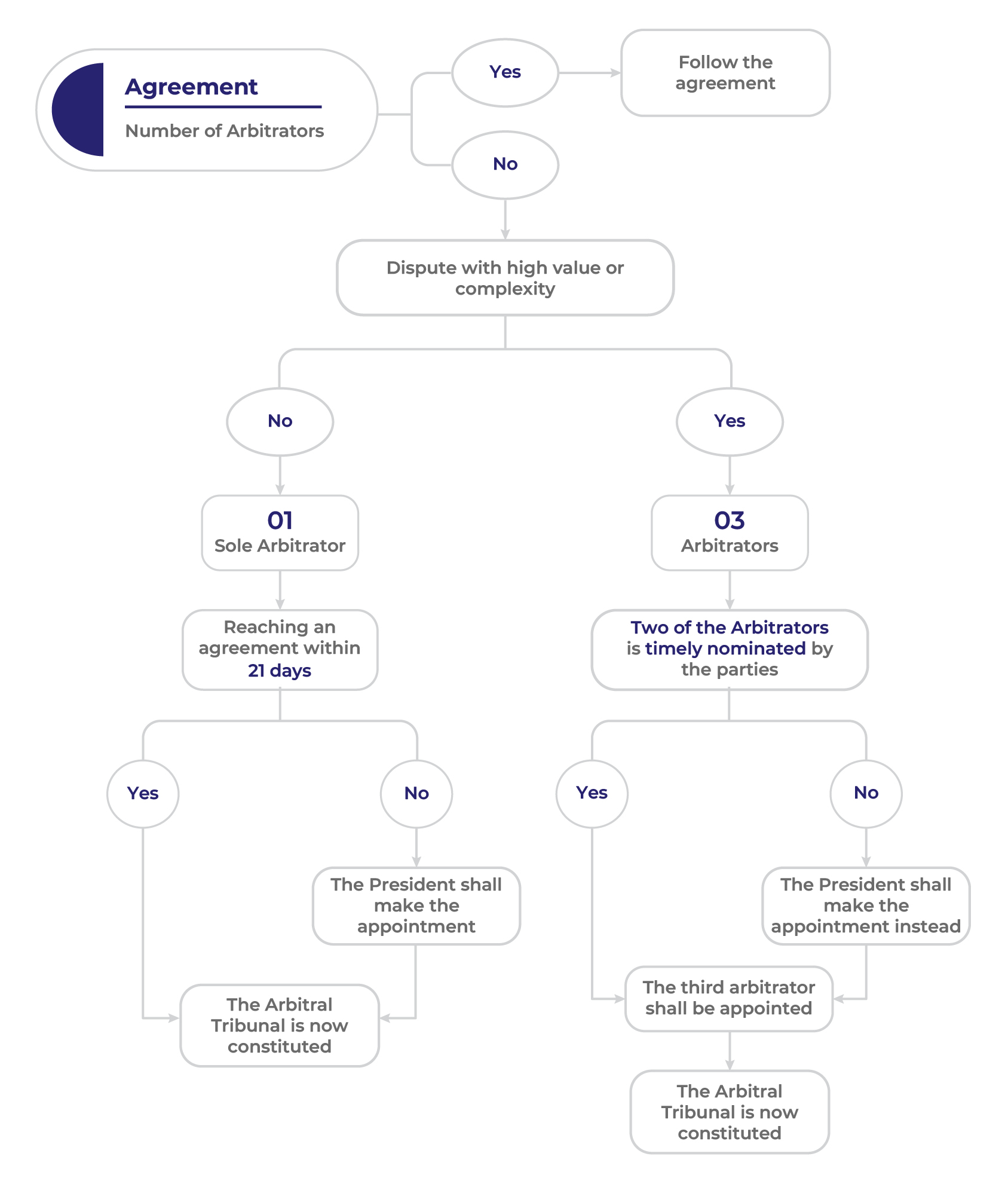
The Constitution of the Arbitral Tribunal during the dispute resolution at SIAC
Challenge of Arbitrators
As a general standard of dispute resolution via Arbitration, the Arbitrators must maintain their independence and impartiality and ensure prompt and efficient dispute resolution. Being one of the leading international arbitration institutions, SIAC has designed a firm procedure for the appointment of Arbitrators so that this standard could be upheld.
Nevertheless, cases of unqualified arbitrators being appointed, while limited, did seldom happen. So as to address this issue, Parties should protect their rights before unqualified arbitrators.
On that basis, SIAC Rules 2016 allow parties to challenge arbitrators. To be specific:
- Ground for challenge: The challenge could be made if circumstances exist that give rise to justifiable doubts regarding the impartiality or independence of the appointed arbitrator;
- The arbitrator does not possess any requisite qualification on which parties have agreed; or
- The arbitrator refuses or fails to acts or perform his function, or de jure or de facto impossibility by arbitrator to act or perform his function.[30]
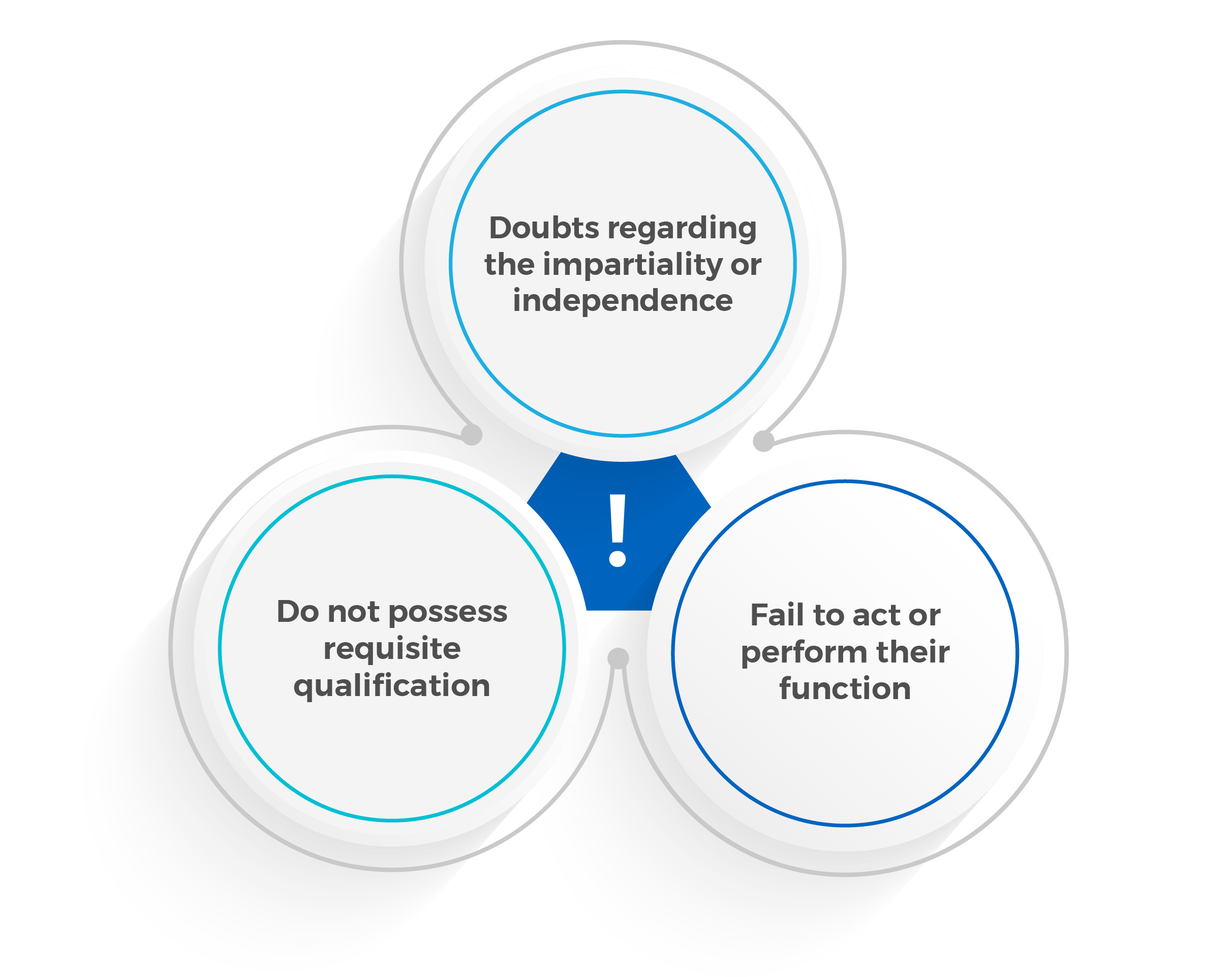
Grounds for a Party to challenge appointed arbitrators during the dispute resolution at SIAC
Notice of Challenge:
SIAC Rules 2016 allow the parties to challenge arbitrators by submitting a notice of challenge to the Registrar, the other party, and all appointed arbitrators within 14 days of the receipt of the notice of appointment of the arbitrator who is being challenged or within 14 days after the circumstances giving rise to the challenge became known or should have been known to the challenging party[31]
Payment of the filing fee for Notice of Challenge:
Based on the Schedule of Fees applicable since 01/01/2025, the Challenge filing fee (non-refundable) is 10,900 Singapore Dollar (which include the 9% Goods and Services Tax) for Singapore parties, and 10,000 Singapore Dollar for oversea parties[32]
Accordingly, upon the receipt of the Notce of Challenge, the Registrar shall set a time limit for the challenging party to pay the Challenge filing fee.
Upon the expiration of this time limit, if the challenging party does not make payment, the challenging party shall be deemed to have withdraw the Notice of Challenge[33].
It is recommended that the challenging party pay this fee at the same time as the submission of the Notice of Challenge so that the review of Notice of Challenge by the Registrar would not be affected.
Assessment of impact on the Arbitration
During the review of the Notice of Challenge, the Registrar shall assess the impact of the challenge of an arbitrator to the arbitration process. Based on the assessment result, the Registrar shall:
- Order a suspension of the arbitral proceeding
- Resume the arbitration with the challenged arbitrator remain as the appointed arbitrator.
Until the Notice of Challenge is resolved by the Court[34]
Decision on Challenge:
Within 7 days of the receipt of the notice of challenge and the payment of the challenge filing fee, the Court shall consult with the parties and all appointed arbitrators to reach an decision on the challenge, accordingly:
- If the Court rejects the challenge to an arbitrator, the challenged arbitrator shall continue with the arbitration
- If the Court accepts the challenge to an arbitrator, the Court shall remove the challenged arbitrator.
This decision of the Court shall be delivered to the Parties by the Registrar. Furthermore, this decision is final and not subject to appeal[35].
Cessation of the Challenged Arbitrator’s Role
SIAC Rules 2016 also specifies the regulation for the cessation of the challenged arbitrator’s role prior to the issuance of the decision on challenge in the following cases:
- The other party agree with the Notice of Challenge, or
- The challenged arbitrator voluntarily withdraw from the case[36].
The consequence of withdrawal by the Challenged Arbitrator
Whether the challenged arbitrator withdraw prior to the issuance of the decision on challenge, or is removed in accordance with the decision on challenge, the challenged arbitrator shall be substituted by another arbitrator who would undergo the same procedures for nomination and appointment as the challenged arbitrator did[37].
Repetition of Hearings
Subsequent to the appointment of a substitute arbitrator, to maintain the independence and impartiality throughout the arbitration process, SIAC Rules 2016 has specified cases where repetition of hearings are required, to be specific[38].
- If the sole or presiding arrbitrator is replaced, any hearings held previously shall be repeated unless otherwise agreed by the party
- If any other arbitrator is replaced, any hearings held previosly may be repeated at the discretion of the Tribunal after consulting with the parties.
- Repetition of hearings are not applicable to any hearings relating solely to issued interim or partial awards. As such, these Award shall remain in effect.
Overall, the challenge of arbitrator could be summed up via the flowchart below:

Flowchart for Challenge of Arbitrator
It should be further noted that: Aside from the cessation of the challenged arbitrator’s role, an appointed arbitrator might still be replaced by another arbitrator in the event of death, resignation, withdrawal or removal of an arbitrator during the course of the arbitral proceedings.[39]
The President may, at his own initiative and in his discretion, remove an appointed arbitrator, if it determined that the appointed arbitrator refuses or fails to act or to perform his functions, or fails to conduct or participate in the arbitration in a manner that ensures the fair, expeditious, economical and final nature of Arbitration.[40]

Grounds for replacement of Arbitrator
Phase 3: Conduct of the Proceedings
Subsequent to the constitution and receipt of the Case’s doucments and materials, the Arbitral Tribunal shall proceed with the dispute resolution in a manner that ensure the fair, expeditious, economical, and final nature of Arbitration.[41]
There is no specific procedure that is applicable to all case. This is attributable to various reason, particularly the principles of party automony. If Parties wish to amicably resolve the dispute, they could either mutually reach an agreement between themselves or request the Arbitral Tribunal to issue an Arbitral Award that record the agreement between the Parties in accordance with Rule [*]. SIAC Rules 2016.
Similarly, if a Party request the Arbitral Tribunal to make an early dismissal of the Case, after having reviewed the parties’ submission and there are substantial basis for the early dismissal of the case, the case would also be concluded.
However, in our experience, CNC find that the conduct of the proceedings by the Arbitral Tribunal could be categorized into 04 (four) groups of works: (i) Conducting of a preliminary meeting for case management (ii) Agreement on the schedule of submission and supervision of the submissions of the parties per the agreed schedule; (iii) Conducting of hearings for resolution of the dispute between the parties; and (iv) Closure of the proceeding.

Four main steps in the in the Conduct of the Proceedings Phase
Case Management meeting
The conducting of the case management meeting is the first action that any Arbitral Tribunal would take subsequent to the constitution. The purpose of this case management meeting is to discuss the procedures that will be most appropriate and efficient for the case.[42]
Subsequent to this preliminary meeting, the Arbitral Tribunal shall proceed with other tasks that are required for the adjudication of the dispute between the Parties, including but not limited to[43]:
- Provide guidance to the parties and reach an agreement on the schedule of the proceeding
- Bifuricate proceeding
- Limit the maximum pages for submissions
- Exclude cumulative or irrelevant testimony or other evidence
- Direct the parties to focus their presentations on issues related to the resolution of case either in part or in whole
- Make Early Dismissal of Claims and Defences
- Order Emergency Interim Relief
Furthermore, at any stage of the proceedings, the Arbitral Tribunal could convene a case management meeting to further discuss the procedures under the request of the President.[44]
Submissions
Subsequent to the initial case management meeting, the Arbitral Tribunal shall set a schedule for written submissions by the parties to gather information and evidence.
Accordingly, unless otherwise agreed by the parties in the schedule or permitted by the Arbitral Tribunal, the submissions of the Parties shall be done in the following sequence”
- Step 1: Claimant submits the Statement of Claim;
- Step 2: Respondent submits the Statement of Defense and/or Counterclaim (if any);
- Step 3: Claimant submits the Statement of Defense to Counterclaim (if any); OR
- Step 3: Claimant makes amendments and supplements to the Statement of Claim;
- Step 4: Respondent makes amendments and supplements to the Statement of Defense and/or Counterclaim (if any); OR
- Step 5: Claimant makes amendments and supplements to the Statement of Defense to Counterclaim (if any).
It should be noted that:
- For the Claimant: The Arbitral Tribunal may issue an order for the termination of the arbitral proceeding if the Claimant fails to submit the Statement of Claim within the specified time;[45]
- For the Respondent: The arbitral proceedings shall continue onward even if the Respondent fails to submit the Statement of Defense.[46]
At the same time, the submission of the parties must include all supporting document, and in each submission, Parties need to establish[47]:
- Relevant statement of facts
- Legal grounds or arguments supporting the claim
- The relief claimed
Subsequent to each submission, if necessary, each party could request the Arbitral Tribunal to allow the amendments and supplements to previous submissions, provided that such amendment and supplement do not fall outside the initial scope, or serve the purpose of delaying the arbitral proceeding.[48]
Morevover, to expand upon issues that have yet to be sufficiently clarified in previous submissions, the Arbitral Tribunal could request the Parties to make further submissions within a fixed duration.[49]
Overall, the submissions of the parties could be summed up as follow:
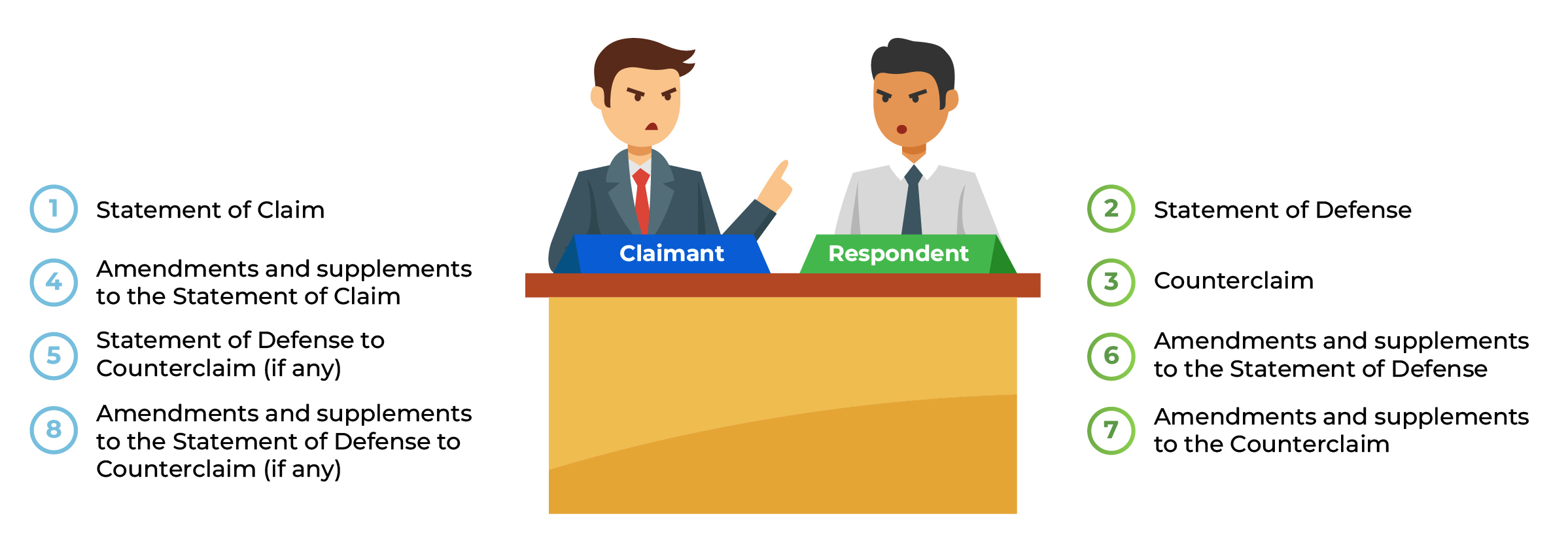
Submissions by the Parties during the Dispute Resolution at SIAC
Hearings[50]
After having received necessary submissions from the Parties and witnesses (including expert witnesses), the Arbitral Tribunal shall proceed to clarify issues that have yet been presented or sufficiently presented by the parties in their submissions through hearings.
Hearings are also opportunities for parties to present their arguments in the most direct and transparent manner possible
Accordingly, for each hearing, the date, time, and location of the hearing shall be fixed by the Arbitral Tribunal and communicated to the parties.
In each hearing, the Arbitral Tribunal could summon witnesses (including expert witnesses) to collect testimony and/or to conduct cross-examine
Furthermore, the hearings and the documents and materials used in the hearings shall be kept confidential unless otherwise agreed by the parties[51].
Closure of the Proceeding
In principle, the Arbitral Tribunal could issue separate Arbitral Award for each issues at different times throughout the arbitral proceeding, unless the parties agreed otherwise.[52]
For issues that require an Arbitral Award to be rendered, the Arbitral Tribunal shall declare the closure of the arbitral proceeding to the Parties and the Registrar, subsequent to:
+ Consultation with the Parties, and
+ Being satisfied that the parties have no further relevant and material evidence to produce or submission to make with respect to the issues to be decided in the Arbitral Award.[53]
However, under the request of one Party or if the Arbitral Tribunal find it necessary, the Arbitral Tribunal could re-open the proceed. In this case, the Arbitral Tribunal’s decision to re-open the proceedings shall also be communicated to the parties and to the Registrar[54]
In summary, the Conduct of the Proceedings Phase is consist of the following steps:
- Step 1: The Arbitral Tribunal receive the case from the Registrar and the Case Management Team
- Step 2: The Arbitral Tribunal consult with the parties to conduct a meeting with them on the management of case.
- Step 3: The Arbitral Tribunal and Parties (might) agree on issues that require resolution and record them in the schedule of submission
- Step 4: Parties make submissions in accordance with the agreed schedule
- Step 5: The Arbitral Tribunal conducts hearings
- Step 6: The Arbitral Tribunal declares termination/closuse of the arbitral proceedings

06 steps in the Conduct of the Proceedings Phase
Phase 4: Arbitral Awards
The dispute resolution at SIAC does not end upon the declaration of the closure of the proceedings by the Arbitral Tribunal. If anything, this declaration only marks the point where the Arbitral Tribunal shall peruse the submissions and opinions of the Parties so that an award could be made.
Simultaneously, to ensure that the dispute resolution at SIAC is transparent, objective, and optimal, particularly the enforceability of the Arbitral Award, SIAC has established strict procedures so as to minimize unclear aspects and format errors in the Arbitral Award.[55]
Specifically, for any case administered by SIAC, the Arbitral Tribunal shall only make Arbitral Awards if the draft of such awards has been approved by the Registrar[56]. Concurrently, subsequent to the making of an Arbitral Award, it is entirely possible for that award to be corrected with regard to its form.[57]
Based on the foundation, the rendering of an Arbitral Award under SIAC Rules 2016 shall go through the following stages: (i) Issuance of the draft Award; (ii) Review of the draft Award; (iii) Making of the Arbitral Award; and (iv) Adjustment of the Arbitral Award (if applicable). To be specific:
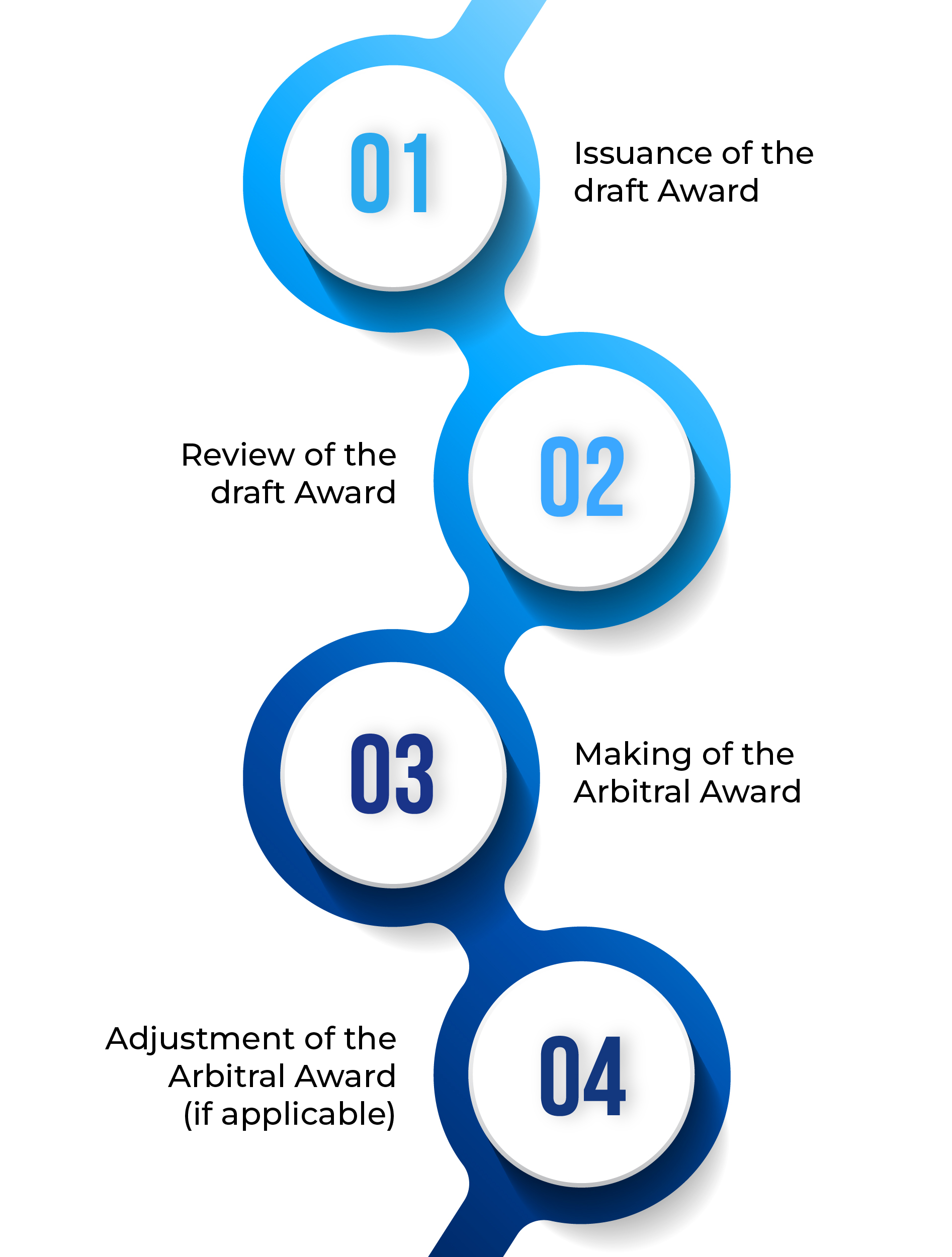
Procedure for the Rendering of Arbitral Awards
Issuance of the draft Award
Within 45 days from the date on which the Arbitral Tribunal declare the closure of the arbitral proceedings, the Arbitral Tribunal must issue the draft Award for the review by the Registrar
Naturally, the Arbitral Tribunal could request the Registrar to extend the duration for the issuance of the draft Award if it find that more time are required.
Review of the draft Award
After receiving the draft Award, the Registrar, as soon as practicable, shall suggest some modification as to the form of the award, and draw the Arbitral Tribunal to focus on substance of the Award, without affecting the Arbitral Tribunal’s liberty to decide the dispute.[58]
There is no defined timeframe for the Registrar to complete the review of the draft Award. Hence, the parties would only know of the completion of the review if the Registrar communicate to them so.
However, in pinciple, the Registrar should complete the review as soon as practicable to ensure the expeditious and economical conclusion of the arbitration per SIAC’s policy[59]
Making of the Arbitral Award
Unless otherwise agreed by the parties, the content of the arbitral award must state[60]:
- The bases and reasoning;
- The total amount of the costs of the arbitration;
- The apportionment of the costs of the arbitration among the parties;
- The apportionment of the legal or other costs among the parties;
The Arbitral Award shall be made based on the majority decision, or failing such decision, the presiding arbitrators alone shall make the arbitral award.[61]
However, the making of Arbitral Award might encounter difficulty if one of the arbitrator fails to cooperate. To address this situation, SIAC Rules 2016 would require the other arbitratos to communicate to the Registrar and the parties of such failure to cooperate.[62]
Subsequently, to decide whether to proceed with the making of the award with or without the cooperation of the uncooperative arbitrator, the remaining arbitrators need to take into account following[63]:
- The stage of the arbitration
- Any explanation provided by the uncooperative arbitrator
- The effect of the failure to cooperate by an arbitrator on the enforceability of the Award should them proceed with the making of the award without the former’s cooperation.
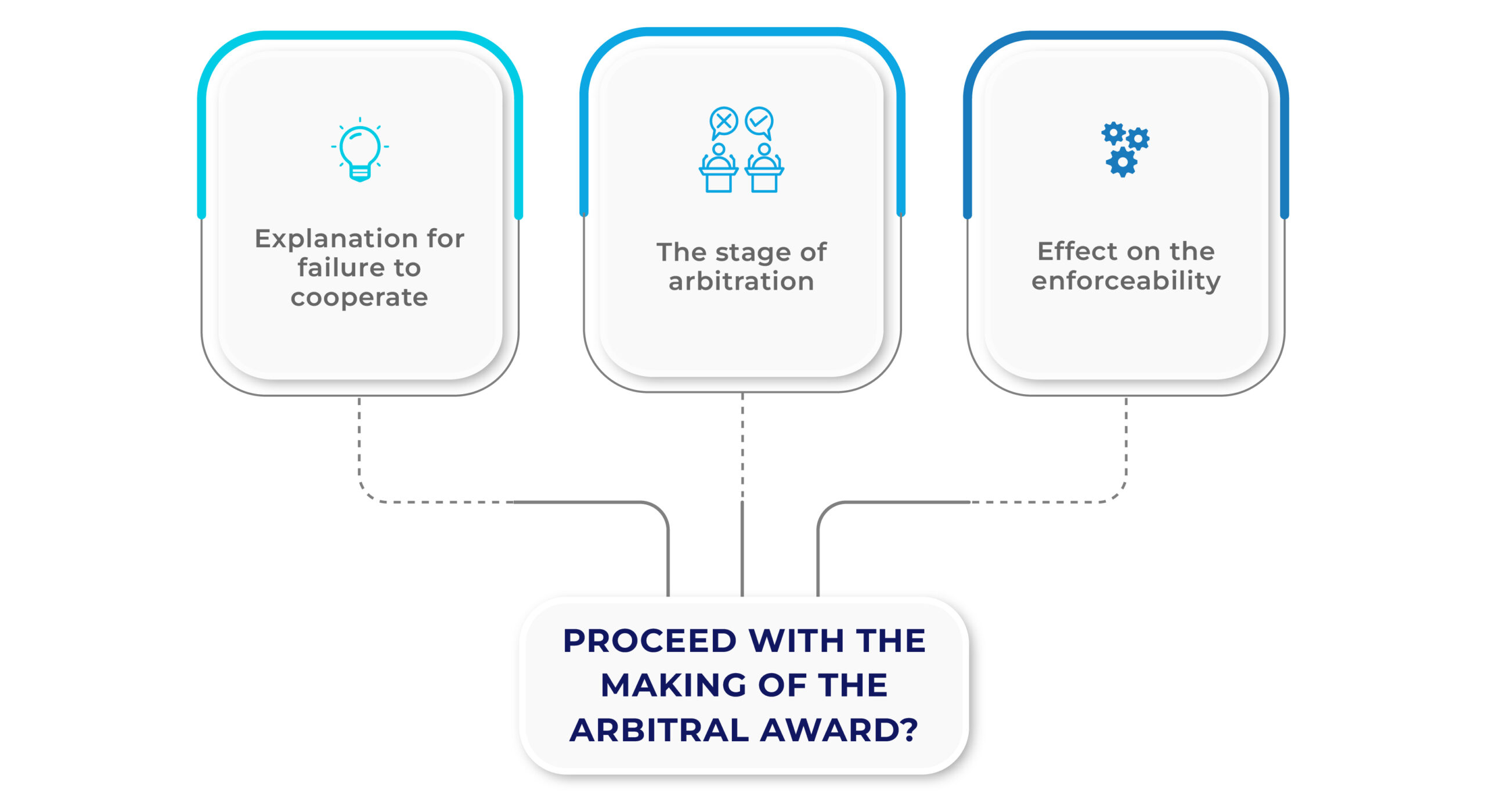
Factors that need to be considered for the making of the Arbitral Award in the context of an arbitrator failing to cooperate
If it is decided that the Arbitral Tribunal shall proceed with the making of Arbitral Award, the remaining arbitrators shall explain in the Award the reasons for proceeding without the uncooperative arbitrator[64]
Finally, the Registrar shall only deliver the Arbitral Award to the parties upon the payment of the arbitration cost by the parties[65]
Adjustment of the Arbitral Award
Within 30 days of the receipt of the Arbitral Award, Parties could send a notice to the Registrar and the other party to request the Arbitral Tribunal to adjust the Arbitral Awards with regard to the following[66]:
- Correction of Awards: Applicable to any error in computation, any clerical or typographical error or any error of a similar nature. Accordingly, the Arbitral Tribunal shall make the correction within 30 days of the receipt of the request if it considers the request to be justified. Alternatively, the correction of awards could also be done on the Arbitral Tribunal’s own initiative
- Additional Awards: Applicable to any claim presented in the arbitration but not dealt with in the Award. Accordingly, the Arbitral Tribunal shall consider the request, and if justified, make the additional Award within 45 days of the receipt of the request.
- Interpretation of Awards: Applicable in the event that one party request an interpretation of the Award to be given. Accordingly, the Arbitral Tribunal shall consider the request, and if justified, provide the interpretation in writing within 45 days of the receipt of the request.
Naturally, if the Arbitral Tribunal find that more time are required to adjust the Arbitral Award, the Arbitral Tribunal could request the Registrar to extend the duration for the adjustment[67]
In summary. Phase 4: Arbitral Awards could be summed up by the flowchart below:

9 steps in the making of the Arbitral Award during the dispute resolution at SIAC under SIAC Rules 2016
Summary of the dispute resolution process at SIAC
Although the dispute resolution at SIAC would vary depending on each particular case, in order to provide Client with an easy to grasp process of dispute resolution at SIAC, CNC hearby present a summary of fundamental steps. To be specific:
Step 1: The Claimant submits a Notice of Arbitration to SIAC
Step 2: The Registrar notify the parties of the commencement of the arbitration
Step 3: The Respondent submits a Response to Notice of Arbitration
Step 4: The Respondent submit a Counterclaim (if any)
Step 5: The Registrar or the Court conduct a preliminary review of the jurisdiction of the Arbitral Tribunal (if applicable)
Step 6: Parties appoint arbitrator and constitute the Arbitral Tribunal
Step 7: Arbitral Tribunal conduct the initial meeting for the arrangement and management of dispute resolution process at SIAC
Step 8: Parties and the Arbitral agree on the schedule of submission
Step 9: One Party request the early dismissal and/or objects the jurisdiction of the Arbitral Tribunal
Step 10: The Abitral Tribunal give a preliminary decision on the matter of jurisdiction (if applicable)
Step 11: Claimant submits a Statement of Claim for the claims given in the Notice of Arbitration (including opinion on expert’s opinion, witness testimonies, etc)
Step 12: Respondent submits a Statement of Defense regarding the claims given by the Claimant (including opinion on expert’s opinions, witness testimonies, etc)
Step 13: Respondent submits a Statement of Counterclaim (including experts’s opinions, witness testimonies, etc)
Step 14: Respondent submits the second Statement of Claim for the claims given in the Notice of Arbitration
Step 15: Claimant submits the Response to Statement of Counterclaim regarding the matters specified in the Statement of Counterclaim (including expert’s opinions and witness testimonies, etc)
Step 15: Respondent submits the Second Statement of Defense regarding the matters specified in the second Statement of Claim
Step 16: Respondent submits the second Statement of Counterclaim
Step 17: Claimant submits the Response to the second Statement of Counterclaim
Step 18: The Arbitral Tribunal requests parties to submit their legal standing and the times allocated to each legal issue (if any) prior to the conducting of Hearings
Step 19: The Arbitral Tribunal consult with the experts (if any)
Step 20: The Arbitral Tribunal conduct Hearings
Step 21: The Arbitral Tribual notifies parties of the (expected) issuance time of the draft Award
Step 22: Registrar review the draft Award
Step 23: The Parties fulfill the payment of Arbitration Cost
Step 24: The Arbitral Tribunal issues the Arbitral Award
Step 25: Parties request the adjustment of Arbitral Award (if any)
Step 26: The Arbitral Tribunal adjusts the Arbtral Award (if applicable)
Conclusion
It is clear that dispute resolution at SIAC under SIAC Rules 2016 is fairly efficient and flexible. This is demonstrated by the commitment of SIAC in relation to provision of international-standard dispute resolution services that are also cost-effective, which affirming the position of SIAC in comparison to other arbitration institutions worldwide
Currently, the Singapore International Arbitration Center (SIAC) has emerged as one of the arbitration institution with the fastest growth in all over the world that pride themselves on their efficient procedures and arbitrators whose expertise are highly rated.
CNC hopes that the above article “Experience on resolution of disputes at VIAC under SIAC Rules 2016” is able to provide Clients with useful information in relation to dispute resolution via arbitration in general and dispute resolution at SIAC in particular.
In the event that further clarification or support regarding dispute resolution at SIAC is required, please contact CNC via the contact information listed below. CNC would be honored to be on receiving end of the Client’s trust and is confident in our abilities to aid Clients in their success in the dispute resolution at SIAC.
Contact
CNC Vietnam Law Firm Co., Ltd
Address: 28 Mai Chi Tho, An Phu Ward, Thu Duc City, Ho Chi Minh City, Vietnam
Phone: (84) 28-6276 9900
Hotline; (84) 916 545 618
Email: contact@cnccounsel.com
Website: cnccounsel.com
Managed by
 |
Mr. Le The Hung | Managing Partner
Phone: (84) 916 545 618 Email: hung.le@cnccounsel.com |
 |
Mr. Tran Pham Hoang Tung | Partner
Phone: (84) 901 334 192 Email: tung.tran@cnccounsel.com |
Disclaimer:
This article is prepared or used for the purpose of introducing or updating Clients on the issues and/or developments of the legal perspectives in Vietnam. The information in this article shall not constitute an advice of any kind and is subject to change without prior notice.
[1] Rules 3.1 and 3.4, SIAC Rules 2016
[2] Rule 3.3, SIAC Rules 2016
[3] Rule 41.2, SIAC Rules 2016
[4] Rule 4.1, SIAC Rules 2016
[5] Rule 28.1, SIAC Rules 2016
[6] Rule 4.1, SIAC Rules 2016
[7] Rule 2.6, SIAC Rules 2016
[8] Rules 3.1 and 3.2, SIAC Rules 2016
[9] See more at: https://siac.org.sg/siac-schedule-of-fees-2025
[10] Rule 3.3, SIAC Rules 2016
[11] Rule 2.1, SIAC Rules 2016
[12] For frequently asked questions in relation to the online case management system, please visit: https://siac.org.sg/faqs/siac-gateway-faqs for more details
[13] Currently, the eletronic portal introduced by SIAC has been put into operation. The Claimant could directly submit the Notice ò Arbitration via the online portal: https://siac-gateway.on.opus2.com/. However, the common method of dispute resolution at SIAC is to make the submission via the email of the Case Management Team.
[14] Rule 4.2, SIAC Rules 2016
[15] Rules 34, 35, SIAC Rules 2016
[16] See more at: https://siac.org.sg/siac-schedule-of-fees-2025
[17] Rule 34.2, SIAC Rules 2016
[18] Rule 34.4, SIAC Rules 2016
[19] Rule 34.6, SIAC Rules 2016
[20] Rule 34.5, SIAC Rules 2016
[21] Rule 34.7, SIAC Rules 2016
[22] Rule 28.1, SIAC Rules 2016
[23] Rule 9.1, SIAC Rules 2016
[24] Rule 41.2, SIAC Rules 2016
[25] Rule 10, SIAC Rules 2016
[26] Rule 11, SIAC Rules 2016
[27] Rules 10.2 and 11.2, SIAC Rules 2016
[28] Rules 9.3 and 9.4, SIAC Rules 2016
[29] Rule 13, SIAC Rules 2016
[30] Rules 14 and 17.2, SIAC Rules 2016
[31] Rules 15.1 and 15.2, SIAC Rules 2016
[32] See more at: https://siac.org.sg/siac-schedule-of-fees-2025
[33] Rule 15.3, SIAC Rules 2016
[34] Rule 15.4, SIAC Rules 2016
[35] Rules 16, SIAC Rules 2016
[36] Rules 15.5, 15.6, and 16.1, SIAC Rules 2016
[37] Rules 15.6 and 16.2, SIAC Rules 2016
[38] Rule 18, SIAC Rules 2016
[39] Rule 17.1, SIAC Rules 2016
[40] Rule 17.3, SIAC Rules 2016
[41] Rule 19.1, SIAC Rules 2016
[42] Rule 19.3, SIAC Rules 2016
[43] Rules 19.4, 29 and 30, SIAC Rules 2016
[44] Rule 19.7, SIAC Rules 2016
[45] Rule 20.8, SIAC Rules 2016
[46] Rule 20.9, SIAC Rules 2016
[47] Rules 20.2 – 20.4, 20.7, SIAC Rules 2016
[48] Rule 20.5, SIAC Rules 2016
[49] Rule 20.6, SIAC Rules 2016
[50] Rule 24, SIAC Rules 2016
[51] Rule 24.4, SIAC Rules 2016
[52] Rule 32.5, SIAC Rules 2016
[53] Rule 32.1, SIAC Rules 2016
[54] Rule 32.2, SIAC Rules 2016
[55] Rules 33 and 41.2, SIAC Rules 2016
[56] Rule 32.3, SIAC Rules 2016
[57] Rule 33, SIAC Rules 2016
[58] Rule 32.3, SIAC Rules 2016
[59] Rule 41.2, SIAC Rules 2016
[60] Rules 32.4, 35.1, and 37, SIAC Rules 2016
[61] Rule 32.7, SIAC Rules 2016
[62] Rule 32.6, SIAC Rules 2016
[63] Rule 32.6, SIAC Rules 2016
[64] Rule 32.6, SIAC Rules 2016
[65] Rule 32.8, SIAC Rules 2016
[66] Rule 33, SIAC Rules 2016
[67] Rule 33.4, SIAC Rules 2016



